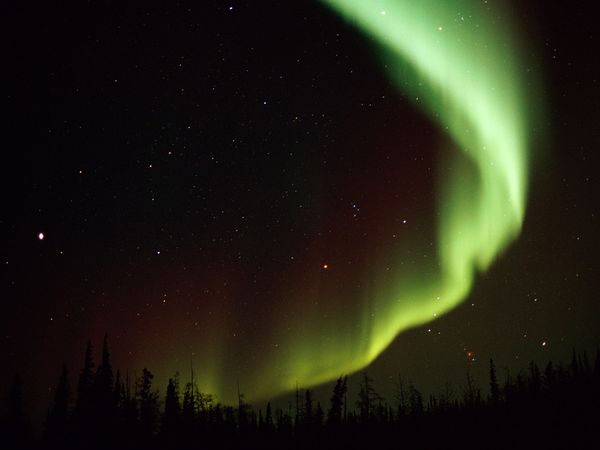Sounds of the Aurora:
hearing lights?
While it is certainly unclear
if the aurora itself makes an audible sound, there have been many
claims suggesting that there are sounds that can be heard when the
aurora is visible in the sky. Scientists, especially, are skeptical.
Their skepticism, of course, is not unfounded. The two main reason
scientists believe that the aurora does not 'make' sound are:
1. There have been no successful recordings of any such sounds. With our advances in sound-capturing technology, to think someone would
have
been able to record it by now.
someone would
have
been able to record it by now.
2. The aurora, as we have already discussed, is really high in the atmosphere. In those levels of the atmosphere, there isn't very much air to allow the propagation of sound waves. Additionally, if there was enough air, it would take the sound waves an incredible amount of time to reach an observer on the ground; this would make it difficult to associate the actual sound with the lights themselves.
However, people do claim to have heard sounds in the general category of whistling, rustling, whooshing, swishing or crackling. Larry Gedney of the University of Alaska Geophysical Institute argues in his article "Sounds of the Aurora":
"If a physical reason does exist for auroral sounds to be audible on the ground, it would most likely be due to the electrical field produced by the aurora. Power fluctuations in long transmission lines have been linked to auroral activity, and there are cases where circuit breakers have been tripped and transformers Photo courtesy of National Geographic
blown during highly active displays."
However, Gedney does go on to argue that some believe that the sound is simply a possible effect of this electrical field on the nervous system, but as this remains unconfirmed as well, no one can truly say whether or not the aurora actually creates a sound. Some also claim that the sound heard by people is a result of their unknowingly having synesthesia, a neuro-biological condition which causes sensors in the brain to confuse the senses (like tasting smells and seeing sounds).
1. There have been no successful recordings of any such sounds. With our advances in sound-capturing technology, to think
 someone would
have
been able to record it by now.
someone would
have
been able to record it by now.2. The aurora, as we have already discussed, is really high in the atmosphere. In those levels of the atmosphere, there isn't very much air to allow the propagation of sound waves. Additionally, if there was enough air, it would take the sound waves an incredible amount of time to reach an observer on the ground; this would make it difficult to associate the actual sound with the lights themselves.
However, people do claim to have heard sounds in the general category of whistling, rustling, whooshing, swishing or crackling. Larry Gedney of the University of Alaska Geophysical Institute argues in his article "Sounds of the Aurora":
"If a physical reason does exist for auroral sounds to be audible on the ground, it would most likely be due to the electrical field produced by the aurora. Power fluctuations in long transmission lines have been linked to auroral activity, and there are cases where circuit breakers have been tripped and transformers Photo courtesy of National Geographic
blown during highly active displays."
However, Gedney does go on to argue that some believe that the sound is simply a possible effect of this electrical field on the nervous system, but as this remains unconfirmed as well, no one can truly say whether or not the aurora actually creates a sound. Some also claim that the sound heard by people is a result of their unknowingly having synesthesia, a neuro-biological condition which causes sensors in the brain to confuse the senses (like tasting smells and seeing sounds).